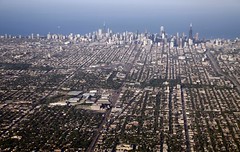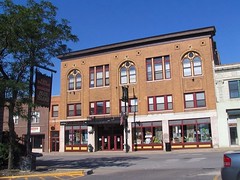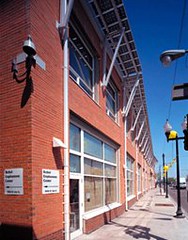Redrawing the American City: sprawl and smart growth in Chicago

Posted January 6, 2010 at 1:45PM
My NRDC colleague Laura Wright has written -- and our independent magazine, OnEarth, has published -- a tour de force article on sprawl and smart growth, using Chicago as its case study. It’s the magazine’s cover story for the current issue and a very big deal for us; until very recently, smart growth was sort of a stepchild in our organization, to tell the truth. Because both the causes of and solutions to unsustainable land development can be so diffuse, it was hard to sell on a large scale to our powers that be and, frankly, sometimes hard to sell to those who fund us, too.
 That has changed a lot in the last couple of years, and I am delighted that OnEarth’s able editor Doug Barasch stayed on this story for a long time through all sorts of obstacles, including a couple of writers that didn’t pan out for various reasons. What Laura has now brought to us is very thorough and well written.
That has changed a lot in the last couple of years, and I am delighted that OnEarth’s able editor Doug Barasch stayed on this story for a long time through all sorts of obstacles, including a couple of writers that didn’t pan out for various reasons. What Laura has now brought to us is very thorough and well written.
(By the way, I was consulted at the beginning, and interviewed for the story, but I did not read or approve any of the copy before it was published. Not that I didn’t ask, mind you: Doug said no. The magazine takes the “independent” part of its mission seriously.)
What I like best about “Redrawing the American City” is that it takes the issues that so many of us have been working on to a new and wider audience. I have long thought that the national environmental community has neglected this issue.  But it is critical that we take it on and educate our constituents, because if environmentally minded citizens don’t get over the still-common, knee-jerk opposition to development that has formed our instincts, sprawl and all its attendant environmental problems will only get worse, not better. We need to understand these issues better so that we take the more sophisticated approach of vigorously supporting good development, especially in existing communities, while vigorously opposing sprawl on the fringe.
But it is critical that we take it on and educate our constituents, because if environmentally minded citizens don’t get over the still-common, knee-jerk opposition to development that has formed our instincts, sprawl and all its attendant environmental problems will only get worse, not better. We need to understand these issues better so that we take the more sophisticated approach of vigorously supporting good development, especially in existing communities, while vigorously opposing sprawl on the fringe.
Chicago was an interesting choice for the story. It was, coincidentally, the same choice that Don Chen, Matt Raimi and I made over a decade ago when we were researching Once There Were Greenfields. But since then I think a lot of cities have produced good examples of smart growth policies and practice, and I might have chosen a different one this time around if I had been writing the story. (I might have gone for Atlanta, a sun-belt city with worse problems when it comes to sprawl, and some very innovative examples of smart growth as well.)
 But Laura did a great job of teasing out the issues in Chicago, using three illustrative stories. One of them concerns the working-class suburb of Blue Island, to the city’s south, somewhat faded but loaded with assets like historic properties, a close-in location, rail infrastructure and underutilized land. Blue Island’s improvements will have to come with substantial zoning changes, though, since in some ways it’s a textbook example of how smart growth remains illegal in too many places because of outmoded regulations. The discussion of what the community’s options are is a very good and pragmatic introduction to the challenges faced by planning officials and the creativity they bring to the task.
But Laura did a great job of teasing out the issues in Chicago, using three illustrative stories. One of them concerns the working-class suburb of Blue Island, to the city’s south, somewhat faded but loaded with assets like historic properties, a close-in location, rail infrastructure and underutilized land. Blue Island’s improvements will have to come with substantial zoning changes, though, since in some ways it’s a textbook example of how smart growth remains illegal in too many places because of outmoded regulations. The discussion of what the community’s options are is a very good and pragmatic introduction to the challenges faced by planning officials and the creativity they bring to the task.
The article also takes on the story of West Garfield Park, and Bethel New Life, a faith-based community development corporation that has long been a leader in Chicago revitalization efforts. The article focuses on their work around the Pulaski station on the Chicago El’s Green Line, which we also applauded in NRDC’s 1991 book, Solving Sprawl. Their accomplishment has progressed since then. Laura’s article also mentions aspects of Bethel’s work on bigger-picture sustainability, which includes family and individual support,  jobs and education, as well as the built environment. Theirs is a very good story, if by its nature an unfinished one.
jobs and education, as well as the built environment. Theirs is a very good story, if by its nature an unfinished one.
I wish the article had found a different suburb, perhaps Naperville’s town center, or a suburban community where adding walkable density was resisted but overcome for its third example (which actually comes first in the article). Instead, it discusses Prairie Crossing, an iconic “conservation development” that is 40 miles from the Loop, low-density, and automobile-dependent (despite a commuter-rail station adjacent to its southwest corner). Prairie Crossing is not without environmental merit, with a large amount of well-conserved land. But, as I have written before, it is not a great example of the kind of smart growth that we need to emulate: it contains fewer than 400 upscale homes on 677 acres, a remarkably inefficient way to build residential development. If all subdivisions were built in this manner, regions would spread out beyond all hope of efficient transportation patterns and saving countryside beyond the fringe.
The article also contains informative passages on Chicago’s regional planning, LEED-ND, and the federal interagency partnership for sustainability. I wish Laura had found a way to include some discussion of the excellent work of NRDC’s smart growth friends in the region (such as the Center for Neighborhood Technology, Congress for the New Urbanism, and Metropolitan Planning Council), but writers and editors do not have unlimited space to work with and, as I said above, one of the magazine’s assets is its independence from NRDC’s day-to-day work.
The story’s web site includes a sidebar link to an interview with yours truly, mostly on the subject of revitalization. All in all, “Redrawing the American City” is a very comprehensive introduction to a complicated subject, using interviews with real people and facts about real places to flesh out the tale. I hope it gets the readership it deserves, and kudos to OnEarth for running it. Go here to read it for yourself.